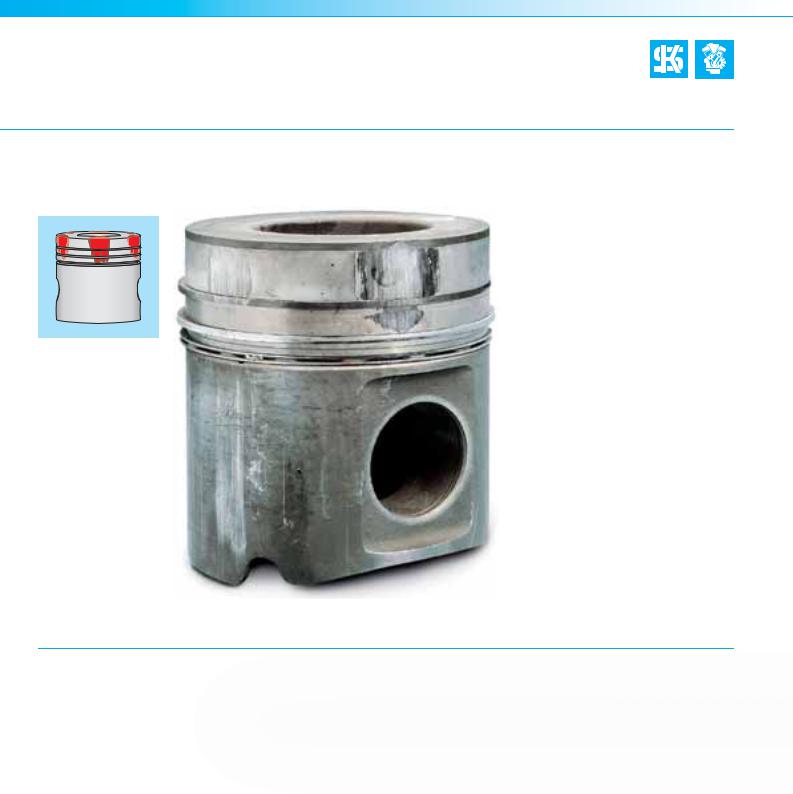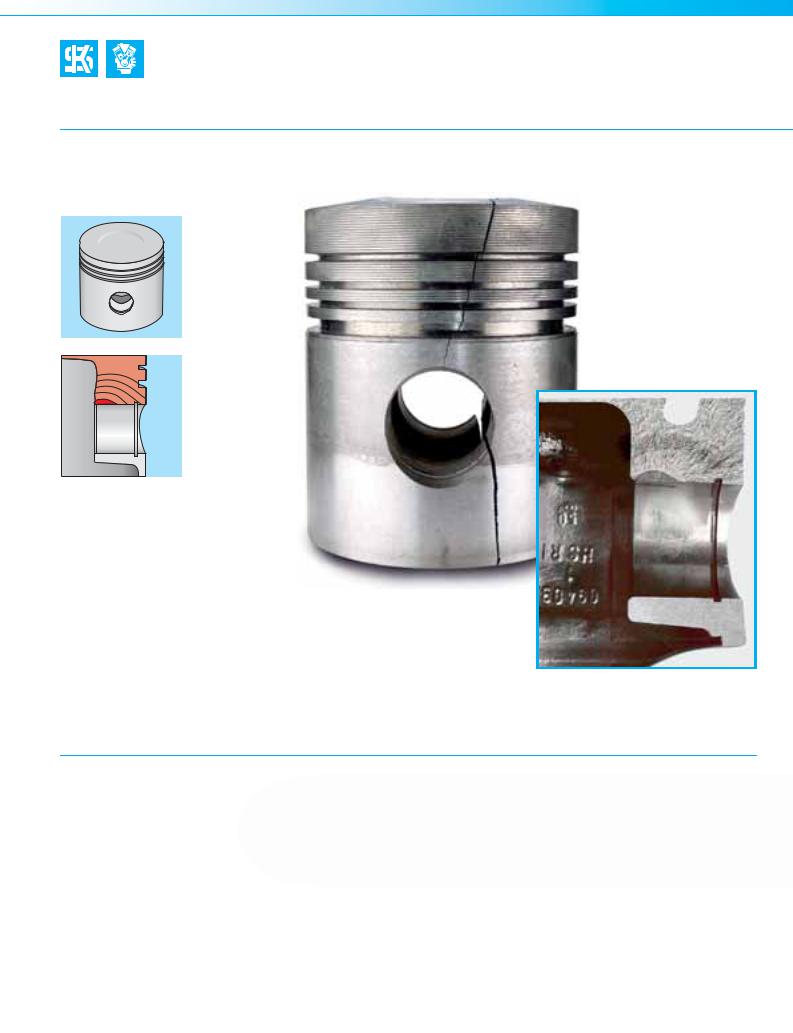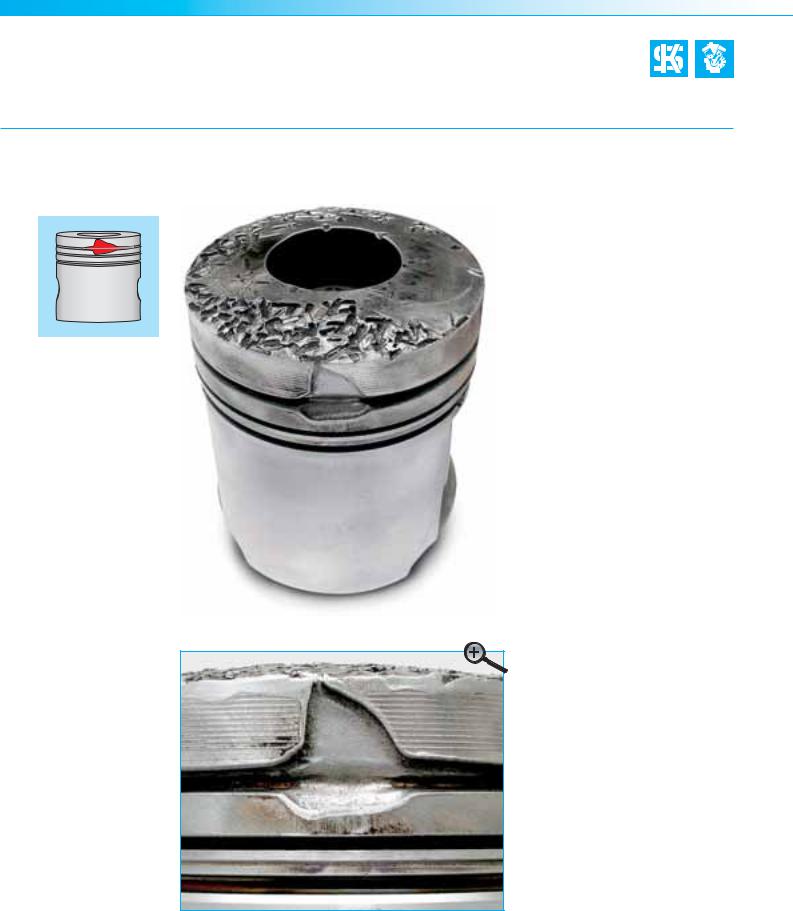
piston_damage
.pdf
Piston damages
Description – assessment – causes
Possible causes for the damage
•Heat range of the spark plugs too low.
•Mixture too lean, resulting in higher combustion temperatures.
•Damaged or leaking valves, or insufficient valve clearance, causing the valves to not close correctly. The combustion gases flowing past significantly increase the temperature of the valves, and the valves start to glow. This primarily affects the exhaust valves, as the intake valves are cooled by the fresh gases.
•Glowing combustion residue on the piston crowns, the cylinder head, the valves and the spark plugs.
•Unsuitable fuel with an octane rating which is too low. The fuel quality must correspond to the compression ratio of the engine, i.e. the octane rating of the fuel must cover the octane requirements of the engine under all operating conditions.
•Gasoline contaminated by Diesel, which lowers the octane rating of the fuel.
•High quantities of oil in the combustion chamber caused by high oil transfer rate due to worn or damaged piston rings or valve guides, or a combination of both.
•High engine or intake temperatures caused by inadequate ventilation of the engine compartment.
•General overheating.
MSI Motor Service International |
Piston damages – Recognising and rectifying | 41 |

Piston damages
Description – assessment – causes
3.4.7 Piston top land seizure due to the use of incorrect pistons (diesel engine)
Description of the damage
Clear localised scoring marks can be seen on the piston top land. These seizure marks go all around the circumference of the piston.
The scoring marks are centered around the piston top land. They start at the edge of the piston crown and end at the second compression ring.
Fig. 1
Damage assessment
Due to the nature of the symptoms, this damage has been clearly caused by an abnormal combustion. However, the fault lies in the use of an incorrect piston, not with the fuel-injection system as might initially be suspected. Within the framework of the legislation for reducing levels of pollutants in exhaust emissions, engines are now designed and built in accordance with the latest exhaust emission standards. Often the pistons for the different emission standards are barely any different to look at. In this example, pistons with different bowl diameters are used on the same range of engines to meet different exhaust emission standards.
One example not to be followed is:
A piston for the Euro 1 emissions standard, which has a bowl diameter of 77 mm, has been replaced during engine repairs with a piston for the Euro 2 emissions standard with a bowl diameter of 75 mm. This caused increased heating at the edge of the bowl as, because of the smaller diameter of the bowl, the injector was spraying onto the edge of the bowl rather than the centre of the bowl. This caused localised overheating of the piston material where the fuel jets from the injector were reaching the piston,
and therefore also increased thermal expansion which led to the localised seizure marks.
If the pistons which are used are not prescribed for the relevant engine type and the relevant emission standards, this can result in serious abnormal combustion during operation with completely unpredictable consequences. Apart from damage of the kind described above, failure to comply with the exhaust emission regulations would be just the start of the problems. Lack of engine performance, increased fuel consumption and subsequent installation of the correct pistons lead to significant follow-up costs.
42 | Piston damages – Recognising and rectifying |
MSI Motor Service International |

Piston damages
Description – assessment – causes
Possible causes for the damage
•Use of pistons with an incorrectly shaped bowl or an incorrect bowl depth or diameter.
•Use of pistons which do not comply with the dimension specifications (compression height).
•Use of the incorrect style of piston. For example, a piston with no cooling oil gallery must not be used if the engine manufacturer specifies a cooling oil gallery the particular application (e.g. for reaching a certain power output).
•Use of the correct pistons, but use of other components which are unsuitable for the particular application (injectors, cylinder head gaskets, fuel-injection pumps or other components which affect the mixture formation or combustion process).
|
|
|
MSI Motor Service International |
Piston damages – Recognising and rectifying | 43 |
|

Piston damages
Description – assessment – causes
3.4.8 Erosion on the piston top land and on the piston crown (gasoline/petrol engine)
Description of the damage
The piston top land shows areas where material has been carried away in an erosion-type process (see Fig. 1). This removal of material often continues on the surface of the piston crown (see Fig. 2). There are not necessarily any seizure marks or other damage to the piston.
Fig. 1
Fig. 2
44 | Piston damages – Recognising and rectifying |
MSI Motor Service International |

Piston damages
Description – assessment – causes
Damage assessment
Erosion-type removal of material from the piston top land and from the piston crown always occurs as a result of extended periods of knocking combustion (medium severity). In the process, pressure waves are generated which spread in the combustion
chamber and run down between the piston top land and the cylinder wall as far as the first compression ring. At the reversal point of the pressure wave, the kinetic energy tears out tiniest particles from the surface of the piston Gradually the area from which
material is carried away expands, particularly if glow ignition also occurs as a result of the knocking combustion.
Material is often carried away in the damaged area behind the rings as far as the oil scraper ring.
Possible causes for the damage
•Use of a fuel without suitable antiknock properties. The fuel quality must correspond to the compression ratio of the engine, i.e. the octane rating of the fuel must cover the octane requirements of the engine under all operating conditions.
•The gasoline/petrol has been contaminated with diesel. Accidental refuelling with the wrong type of fuel or shared use of tanks or canisters for both types of fuel can lead to this kind of contamination. Very small amounts of diesel are already enough to significantly lower the octane rating of the petrol.
•Large quantities of oil in the combustion chamber caused for example by worn piston rings, valve guides or the turbocharger (or other similar components) will reduce the antiknock properties of the fuel.
•Excessively high compression ratio caused by combustion residue on the piston crowns and cylinder head or excessive machining of the cylinder block surface and cylinder head surface for engine overhaul or tuning purposes.
•Ignition timing too advanced.
•Mixture too lean, resulting in higher combustion temperatures.
•Intake air temperatures too high, caused by inadequate ventilation of the engine compartment or exhaust gas backpressure. However, failure to switch over the intake air flap to summer operation or a faulty automatic switchover mechanism will lead also to a substantial increase in the intake air temperature (particularly on older carburettor engines).
MSI Motor Service International |
Piston damages – Recognising and rectifying | 45 |

Piston damages
Description – assessment – causes
3.5 Piston and piston ring fractures
3.5.0 General information about piston fractures
During operation of the engine, pistons can break as a result of an overload breakage or can suffer a fatigue fracture.
An overload breakage (Fig. 1) is always caused by a foreign body which collides with the piston while the engine is running. This could be parts of the connecting rod, crankshaft or valves etc. which have been torn off. An overload breakage of the piston can also occur if water or fuel gets into the cylinder. The broken surfaces
of an overload breakage appear grey.
Fig. 1
In the case of a fatigue fracture (Fig. 2), nodal line markings form on the fracture surface which reveal the starting point and the gradual progress of the fracture. The fracture surfaces are often worn to the point of being shiny. The cause for a
fatigue fracture is overstressing of the piston material. Overstressing can
occur during knocking combustion,
Fig. 2
They are not worn down and they display no nodal line markings. The piston breaks suddenly, with no development of a fracture.
severe shock vibrations of the piston, for example if the piston crown has mechanical contact with the cylinder head or excessive skirt clearance. Excessive deformation of the piston pin due to overstressing (warping and oval deformation) cause cracks in the pin boss. Furthermore, fatigue fractures can also stem from heat stress cracks on the piston crowns.
46 | Piston damages – Recognising and rectifying |
MSI Motor Service International |

Piston damages
Description – assessment – causes
3.5.1 Piston fracture in the piston pin boss
Description of the damage
The early stages of a typical pin boss fatigue crack are evident in the centre axis of the piston pin bore (Fig. 2). The crack has spread in a semicircle around its starting point. A so-called cleavage fracture forms from the initial crack, which splits the piston up to the piston crown into two parts – as can be seen in Fig. 1 (the piston has been sawed
Fig. 1
open from the bottom for the purposes of investigation; the original crack extended from the piston pin bore to
the piston crown). |
Fig. 2 cross section of the piston pin boss |
|
Damage assessment
Boss fractures arise as a consequence of excessive loads. This process can be accelerated if there is not a sufficient
oil supply. An incipient crack in the piston pin boss formed due to excessive loads will then spread even under
normal loads, and will ultimately cause the entire piston to split or break.
Possible causes for the damage
•Abnormal combustion, in particular spontaneous combustion caused by ignition delay.
•Excessive or inappropriate use of starting aids during cold starts.
•The cylinder has filled up with water, fuel or oil whilst stationary, resulting in a hydraulic lock.
•Performance enhancements (e.g. chip tuning) with continued use of the standard production piston.
•Use of incorrect or weight-reduced piston pins. The piston pin is deformed to an oval shape, placing excessive loads on the bearings in the process.
MSI Motor Service International |
Piston damages – Recognising and rectifying | 47 |

Piston damages
Description – assessment – causes
3.5.2 Piston fracture due to mechanical contact between the piston crown and the cylinder head
Description of the damage
Impact marks can be seen on the piston crown in Fig. 1. The piston crown has mechanical contact damage, causing vibration. As a result of the shock vibrations and the effects of the violent impact during the pistons cyclic operation, a fracture has occured in the direction of the piston pin.
On the piston in Fig. 2 the piston skirt has broken off in the lower oil scraper ring groove. The surfaces at the fracture display the characteristics of a fatigue fracture.
Fig. 1
Fig. 2
48 | Piston damages – Recognising and rectifying |
MSI Motor Service International |

Piston damages
Description – assessment – causes
Damage assessment
Due to the exceptionally fast sequence |
ring (like the one shown in Fig. 2), the |
the cylinder wall with its skirt. As the |
of hard impacts as the piston crown |
skirt nearly always breaks in the area |
material thickness is less in the area |
strikes the cylinder head, the piston |
of the lower oil scraper ring groove. |
of the lower ring groove than in e.g. |
is subjected to such violent shock |
After striking the cylinder head, the |
the piston top land, this is where the |
vibrations that cracks are generated. |
piston no longer runs straight in the |
piston breaks. |
On pistons with a lower oil scraper |
cylinder and subsequently strikes |
|
Possible causes for the damage
• The so-called gap dimension (this is |
b )Insufficient thickness of the cylin- |
Caution: |
|
the minimum distance between the |
der head gasket. Many manufactur- |
Checking the freedom of movement |
|
piston crown and the cylinder head) |
ers provide cylinder head gaskets |
of the engine after an overhaul by |
|
was too small at TDC of the piston. |
with different thicknesses for the |
turning the engine several times by |
|
The following scenarios may have |
same engine. On the one hand this |
hand with the engine being cold does |
|
caused this: |
is necessary to compensate for com- |
not guarantee that the piston will not |
|
|
ponent tolerances during produc- |
strike the cylinder head when the |
|
a) Installation of pistons with an |
tion, and on the other hand it also |
engine is at operating temperature. |
|
incorrect compression height. Dur- |
allows an adaptation for the piston |
As the piston and connecting rod |
|
ing engine overhauls, the sealing |
protrusion during repairs. For this |
heat up, they also expand in terms |
|
surface of the cylinder block is often |
reason it is extremely important to |
of their length, which reduces the |
|
reworked. If pistons with the original |
ensure that a cylinder head gasket |
gap between the piston crown and |
|
compression height are then refitted |
with the prescribed thickness is |
the cylinder head. Particularly on |
|
after the engine block is resurfaced, |
used during repairs. This is the only |
larger engines in commercial vehicles |
|
then the piston protrusion/overlap |
way to ensure that the specified gap |
with large compression heights, the |
|
may be too large. This is why pis- |
dimension will be achieved after the |
differences can be significant and |
|
tons are available for repairs with |
repair. The thickness of the gasket |
reduce the freedom of movement of |
|
a reduced compression height, |
must be redetermined depending |
the piston at TDC by several tenths of |
|
enabling the piston protrusion to be |
on the piston protrusion in ac- |
a millimetre. |
|
kept within the tolerance specified |
cordance with the manufacturer’s |
|
|
by the engine manufacturer.* |
specifications if the cylinder block is |
• Excessive clearances in the connect- |
|
|
reworked or replaced. |
ing rod bearings or a worn out con- |
|
|
|
necting rod bearing, particularly in |
|
|
|
conjunction with over-revving during |
|
|
|
a hill descent. |
|
|
|
|
|
|
|
|
|
*MSI supply pistons with a reduced compression height for most heavy duty engines. Please refer to our current cataloque “ Pistons/Cylinders/Kit Sets”.
MSI Motor Service International |
Piston damages – Recognising and rectifying | 49 |

Piston damages
Description – assessment – causes
3.5.3 Material washout in the ring zone (ring fracture)
Description of the damage
Severe material washout reaching as far as the piston crown is evident in the ring zone in the area of the first ring groove. The ring groove displays severe axial wear. Heavy imprints from broken fragments of the first ring can be seen on the piston crown. In some places the running pattern of the piston skirt has a matt, buffed appearance.
Fig. 1
Fig. 2
50 | Piston damages – Recognising and rectifying |
MSI Motor Service International |
